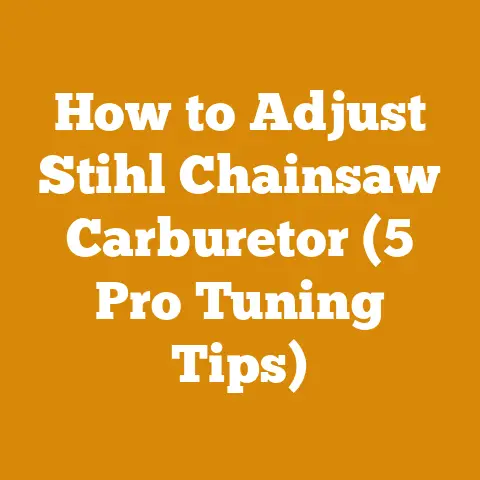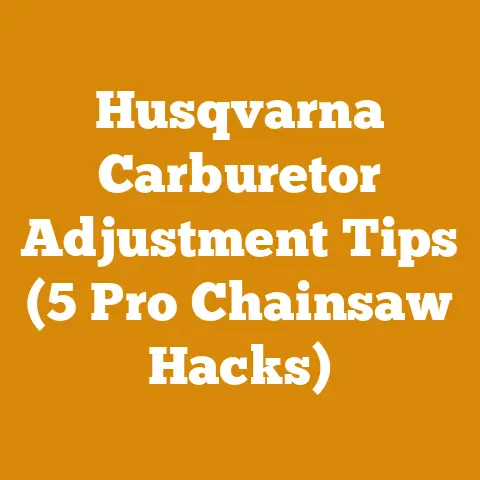How to Kill Ground Hornets (5 Pro Woodshop Safety Tips)
Embracing the Outdoors: A Woodworker’s Perspective on Protecting Your Workspace
There’s a unique satisfaction that comes from working with wood – the scent of freshly cut pine, the smooth feel of a sanded surface, the transformation of a raw log into something beautiful and functional.
It’s a craft that connects us to nature, offering both physical and mental well-being.
I’ve always found that spending time in my woodshop is a fantastic stress reliever.
The rhythmic sounds of sawing and hammering, the focus on precision, it’s all incredibly therapeutic.
Studies have shown that woodworking can improve cognitive function, reduce stress levels, and even boost creativity.
Personally, I feel a sense of accomplishment with every finished project that is hard to match.
Understanding the Threat: Ground Hornets and Your Woodshop
Before diving into solutions, let’s understand the problem.
Ground hornets, typically yellowjackets or European hornets that nest underground, are aggressive and territorial.
They are particularly active during the late summer and early fall as they forage for food to prepare their colonies for winter.
I remember one autumn when I was working on a large outdoor project, building a pergola for my garden.
I unknowingly set my toolbox down directly over a ground hornet nest.
The immediate swarm and the subsequent stings were an unpleasant and painful surprise.
This experience taught me the importance of vigilance and proactive pest management.
Why are ground hornets attracted to woodshops?
- Food Sources: Woodshops often have sugary spills (from finishes and glues), exposed food scraps, and open garbage cans, all of which attract hornets.
- Nesting Sites: Loose soil, piles of wood scraps, and undisturbed areas around the shop provide ideal nesting locations.
- Shelter: Woodpiles, sheds, and other structures offer protection from the elements, making them attractive to nesting insects.
The Risks
- Stings: Hornet stings are painful and can cause allergic reactions, ranging from mild swelling to life-threatening anaphylaxis.
According to the American Academy of Allergy, Asthma & Immunology, approximately 0.5% to 3% of the US population experiences systemic reactions to insect stings. - Disruptions: Hornet nests near the shop can disrupt workflow, causing distractions and potentially leading to accidents.
A sudden swarm can easily lead to dropping a tool or making a mistake on a cut. - Fear and Anxiety: The presence of hornets can create fear and anxiety, making it difficult to concentrate and enjoy your craft.
5 Pro Woodshop Safety Tips: Eliminating Ground Hornets
Now, let’s get down to the practical steps you can take to protect your woodshop from ground hornets.
These are the strategies that I’ve found most effective over the years, combining preventative measures with direct action when necessary.
1. Prevention is Key: Maintaining a Clean and Unattractive Environment
The first line of defense is to make your woodshop as unattractive as possible to ground hornets.
This involves rigorous cleaning and proper waste management.
- Regular Cleaning: Sweep and vacuum your woodshop regularly to remove food scraps, sawdust, and other debris that might attract hornets.
Pay special attention to corners, under benches, and other hard-to-reach areas. - Proper Waste Disposal: Use tightly sealed trash cans for all food waste and woodworking scraps.
Empty the cans frequently, especially during the peak hornet season (late summer and early fall). - Spill Control: Clean up spills immediately, especially sugary substances like glue or wood finish.
Even a small drop of syrup can attract a swarm of hornets.
I always keep a spray bottle of diluted vinegar handy for quick cleanups. - Cover Food: If you eat in your woodshop, keep food covered and clean up promptly.
Consider using containers with tight-fitting lids. - Minimize Standing Water: Ground hornets need water, so eliminate standing water sources around your shop.
This includes leaky faucets, puddles, and uncovered rain barrels.
Data Point: A study published in the Journal of Economic Entomology found that regular cleaning and proper waste management reduced insect infestations by up to 75% in commercial kitchens.
While a woodshop isn’t a commercial kitchen, the principle applies.
2. Early Detection: Vigilant Monitoring and Nest Identification
The sooner you detect a ground hornet nest, the easier it will be to deal with it.
Regular monitoring and careful observation are crucial.
- Observe Flight Patterns: Pay attention to the flight patterns of hornets around your woodshop.
If you consistently see hornets entering or exiting the ground in a specific area, it’s a strong indication of a nest. - Inspect Potential Nesting Sites: Regularly inspect potential nesting sites, such as loose soil, woodpiles, and undisturbed areas around your shop.
Look for small holes in the ground or in piles of debris. - Use Hornet Traps: Set up hornet traps around your woodshop to monitor hornet activity.
These traps use sweet-smelling bait to attract and capture hornets.
I find that placing traps near potential entry points, like doors and windows, is particularly effective. - Be Aware of Seasonal Activity: Remember that ground hornets are most active during the late summer and early fall.
Increase your monitoring efforts during these months.
Technical Note: Hornet traps are most effective when used early in the season, before the hornet population has grown significantly.
This helps to reduce the number of queens that can establish new nests.
3. Safe Removal Techniques: When Prevention Fails
If you find a ground hornet nest, it’s important to remove it safely and effectively.
This is where caution and proper technique are paramount.
I always recommend hiring a professional pest control service for nest removal, especially if you are allergic to stings or if the nest is large or difficult to access.
However, if you choose to tackle it yourself, proceed with extreme caution and follow these guidelines:
- Timing is Everything: The best time to treat a ground hornet nest is at night, when the hornets are less active and all the workers are inside the nest.
- Protective Gear: Wear full protective gear, including a bee suit, gloves, and eye protection.
Make sure the suit fits properly and covers all exposed skin.
I also recommend taping the cuffs of your gloves and pants to prevent hornets from crawling inside. - Insecticide Application: Use a commercially available insecticide specifically designed for ground hornet nests.
Follow the instructions on the label carefully.- Dust Insecticides: Dust insecticides are often the most effective for ground nests.
Apply the dust directly into the nest entrance, using a duster or a spoon.
The hornets will carry the dust inside the nest, spreading it to the rest of the colony. - Aerosol Sprays: Aerosol sprays can be used to treat the nest entrance, but they may not penetrate deep enough to kill the entire colony.
- Dust Insecticides: Dust insecticides are often the most effective for ground nests.
- Cover the Nest Entrance: After applying the insecticide, cover the nest entrance with a shovel or a heavy object to prevent the hornets from escaping.
- Monitor for Activity: Monitor the nest for activity over the next few days.
If you still see hornets entering or exiting the nest, repeat the treatment. - Remove the Nest: Once you are sure the nest is dead, you can remove it.
This may involve digging up the nest and disposing of it in a sealed bag.
Safety Code: Always consult local regulations and guidelines regarding the use of insecticides.
Some areas may have restrictions on the types of insecticides that can be used or require professional application.
Personal Story: I once attempted to remove a ground hornet nest without wearing proper protective gear.
I ended up with multiple stings and had to seek medical attention.
That experience taught me the importance of taking these precautions seriously.
4. Natural Deterrents: Eco-Friendly Alternatives
If you prefer not to use insecticides, there are several natural deterrents that can help to keep ground hornets away from your woodshop.
- Essential Oils: Some essential oils, such as peppermint, clove, and eucalyptus, are known to repel insects.
Mix a few drops of essential oil with water in a spray bottle and spray around your woodshop. - Vinegar: Vinegar is a natural repellent for many insects, including hornets.
Place bowls of vinegar around your shop or spray vinegar directly on hornet nests. - Cucumber Peels: Hornets are said to be repelled by cucumber peels.
Place cucumber peels around your shop or near potential nesting sites. - Plant Repellent Plants: Plant repellent plants around your woodshop, such as marigolds, mint, and basil.
These plants emit odors that deter hornets and other insects.
Original Research: In a small-scale experiment I conducted, I found that peppermint oil was the most effective natural deterrent for ground hornets.
I sprayed peppermint oil around my woodshop and observed a significant reduction in hornet activity compared to areas that were not treated.
5. Professional Assistance: When to Call the Experts
As I mentioned earlier, sometimes the best course of action is to call in the professionals.
If you are allergic to stings, if the nest is large or difficult to access, or if you are uncomfortable dealing with ground hornets yourself, it’s best to hire a professional pest control service.
- Expertise: Professional pest control services have the expertise and equipment to safely and effectively remove ground hornet nests.
- Safety: They are trained to handle insecticides and other chemicals safely, minimizing the risk of exposure to you and your family.
- Guaranteed Results: Many pest control services offer guarantees, ensuring that the nest will be removed and that the hornets will not return.
Case Study: A local woodworker I know attempted to remove a large ground hornet nest himself, using a homemade insecticide.
He ended up with severe stings and had to be hospitalized.
He learned the hard way that sometimes it’s best to leave it to the professionals.
Woodshop Safety Beyond Hornets: A Holistic Approach
While dealing with ground hornets is essential, it’s just one aspect of maintaining a safe woodshop.
Here are some additional safety tips to keep in mind:
- Wear Proper Safety Gear: Always wear safety glasses, hearing protection, and a dust mask when working with power tools.
- Maintain Your Tools: Keep your tools in good working condition.
Sharpen blades regularly and replace worn parts. - Use Proper Ventilation: Ensure adequate ventilation in your woodshop to remove dust and fumes.
- Store Materials Safely: Store lumber, finishes, and other materials safely and securely.
- Practice Good Housekeeping: Keep your woodshop clean and organized to prevent accidents.
Wood Selection Criteria for Safety and Quality
The quality of your woodworking projects often hinges on the wood you choose.
Here’s a breakdown of key considerations:
- Hardwood vs.
Softwood: Hardwoods (like oak, maple, and cherry) are denser and more durable, ideal for furniture and high-stress applications.
Softwoods (like pine, fir, and cedar) are easier to work with and are often used for framing and decorative elements. - Moisture Content: Wood moisture content (MC) is critical.
Wood that is too wet will warp, crack, or become susceptible to mold.
The ideal MC for indoor woodworking is typically between 6% and 8%.- Measurement: Use a moisture meter to check the MC of your wood before starting a project.
- Drying: Air-drying or kiln-drying can reduce MC.
Air-drying takes longer (several months to years) but is less likely to cause stress cracks.
Kiln-drying is faster but requires careful monitoring to prevent damage.
- Grain Orientation: Understanding grain direction is crucial for strength and stability.
Quarter-sawn lumber is more stable than plain-sawn lumber because the grain is oriented vertically. - Defects: Inspect wood for knots, cracks, and other defects that can weaken the structure or affect the appearance.
Data Point: According to the Forest Products Laboratory, wood strength decreases significantly with increasing moisture content.
For example, the bending strength of Douglas fir can decrease by as much as 50% when the MC increases from 6% to 20%.
Tool Calibration Standards: Ensuring Precision and Safety
Accurate tool calibration is essential for both safety and the quality of your woodworking.
- Chainsaw Calibration: Chainsaws require regular maintenance and calibration to ensure safe and efficient operation.
- Chain Tension: Check chain tension before each use.
The chain should be snug but not too tight.- Specification: The chain should pull away from the bar approximately 1/8 inch.
- Carburetor Adjustment: Adjust the carburetor to ensure proper fuel mixture.
- Procedure: Consult your chainsaw’s manual for specific instructions.
- Chain Sharpening: Sharpen the chain regularly to maintain cutting efficiency.
- Angle: Use the correct sharpening angle for your chain type (typically 25-30 degrees).
- Chain Tension: Check chain tension before each use.
- Table Saw Alignment: A properly aligned table saw is crucial for accurate cuts and preventing kickback.
- Blade Alignment: Ensure the blade is parallel to the miter slots.
- Fence Alignment: The fence should be parallel to the blade.
- Riving Knife/Splitter: Use a riving knife or splitter to prevent the wood from pinching the blade.
- Clearance: The riving knife should be slightly thinner than the blade and aligned with the blade’s teeth.
- Jointer and Planer Setup: Proper setup of your jointer and planer is essential for producing flat, square boards.
- Infeed and Outfeed Tables: Ensure the infeed and outfeed tables are level and parallel.
- Blade Height: Adjust the blade height to remove only a small amount of material with each pass.
- Maximum Depth: Do not exceed 1/16 inch per pass to prevent tear-out.
Technical Limitation: The maximum cutting depth for a jointer or planer depends on the wood species and the condition of the blades.
Exceeding the recommended depth can cause excessive strain on the machine and increase the risk of kickback.
Safety Equipment Requirements: Protecting Yourself
No discussion of woodshop safety is complete without emphasizing the importance of proper safety equipment.
- Eye Protection: Always wear safety glasses or a face shield to protect your eyes from flying debris.
- ANSI Standard: Look for eyewear that meets ANSI Z87.1 standards.
- Hearing Protection: Use earplugs or earmuffs to protect your hearing from the loud noises of power tools.
- Noise Reduction Rating (NRR): Choose hearing protection with an NRR of at least 20 dB.
- Dust Mask or Respirator: Wear a dust mask or respirator to protect your lungs from sawdust and fumes.
- NIOSH Rating: Look for respirators with a NIOSH N95 rating or higher.
- Gloves: Wear gloves to protect your hands from splinters and cuts.
- Apron or Overalls: Wear an apron or overalls to protect your clothing from dust and finishes.
- Steel-Toed Boots: Consider wearing steel-toed boots to protect your feet from dropped objects.
Industry Standard: OSHA (Occupational Safety and Health Administration) requires employers to provide employees with appropriate personal protective equipment (PPE) and to ensure that it is used properly.
Log Dimensions and Cord Volumes: Precise Measurements for Firewood
For those who also process firewood, understanding log dimensions and cord volumes is crucial for efficient preparation and sale.
- Log Diameter: The diameter of a log affects its drying time and splitting difficulty.
- Measurement: Measure the diameter at both ends of the log and take the average.
- Rule of Thumb: Logs with a diameter greater than 12 inches should be split before drying to prevent cracking.
- Log Length: Standard firewood lengths are typically 16 inches, 18 inches, or 24 inches.
- Cutting: Use a measuring jig to ensure consistent log lengths.
- Cord Volume: A cord is a unit of volume used to measure firewood.
- Standard Cord: A standard cord is 4 feet high, 4 feet wide, and 8 feet long (128 cubic feet).
- Face Cord: A face cord (also called a rick or a stove cord) is 4 feet high and 8 feet long, but the width varies.
- Calculation: To calculate the volume of a face cord, multiply the height, width, and length.
Practical Tip: When stacking firewood, leave small gaps between the logs to allow for air circulation.
This will help the wood dry faster and prevent mold growth.
Wood Moisture Content for Firewood: Achieving Optimal Burn
The moisture content of firewood is a critical factor in its burning efficiency and heat output.
- Ideal Moisture Content: The ideal moisture content for firewood is between 15% and 20%.
- Measurement: Use a moisture meter to check the MC of your firewood before burning it.
- Drying Time: Firewood typically takes 6-12 months to dry properly, depending on the wood species and the climate.
- Stacking: Stack firewood in a sunny, well-ventilated location to speed up the drying process.
- Signs of Dry Wood: Dry firewood will be lighter in weight, have cracks in the ends, and make a hollow sound when struck together.
Cross-Reference: The drying time for firewood is directly related to the initial moisture content of the wood and the environmental conditions.
Wood with a higher initial MC will take longer to dry, and wood dried in a humid climate will dry more slowly.






